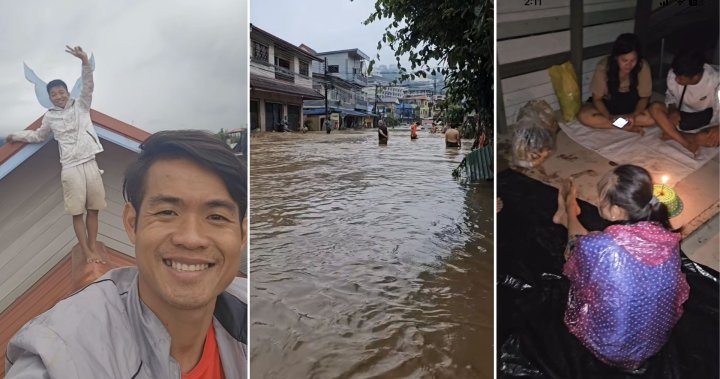Thai cave boys’ coach trapped again, this time by typhoon flooding – National

[ad_1]
The soccer coach of 12 boys who were famously trapped in a cave in northern Thailand in 2018 became stuck again this week, this time forced to spend a night perched on a rooftop during flash floods in the country.
Ekkapol Chantawong told Agence France-Presse that Typhoon Yagi forced him, his family, his girlfriend and her aunt onto the roof of their home in the northern Thai district of Mae Sai on Tuesday. He said they had no time to escape the flash flooding.
The typhoon, which marooned thousands of people in the country’s north, has triggered deadly flooding and landslides in northern Thailand, Vietnam, Laos and Myanmar.
Chantawong shared several videos of the rising water to his Instagram account. In one clip from Wednesday, Chantawong is sitting atop a red roof as he records the rushing, murky water filling the street below.
He called the situation “very serious” and said the home’s front wall had been destroyed by the flooding.
Over six years ago, Chantawong and 12 boys from a soccer team he coached, called the Wild Boars, became trapped inside Thailand’s Tham Luang cave complex. Rising floodwater kept them in the cave for nearly three weeks until an international rescue operation freed the coach and the boys. The mission required a team of skilled divers, who used anesthesia on the boys before transporting them out of the cave system on specialized stretchers.

Get daily National news
Get the day’s top news, political, economic, and current affairs headlines, delivered to your inbox once a day.
Chantawong told AFP his experience trapped inside the cave helped him to calmly navigate the flooding in northern Thailand this week.
“I do not think it is different,” he said. “First we have to focus and start solving the problem we are facing. I do not feel more pressure with this stranding. I see more of a way out.”
“I was scared but I told myself I have to be calm. Wait and assess the situation,” Chantawong told AFP.
The flooding has since receded.
When they were able to leave the rooftop on Wednesday, Chantawong shared more video of the water. In one clip, he stands in the flood alongside other villagers, some of whom are immersed nearly to their hips.
In another video posted to his social media account on Thursday morning, Chantawong said he was safely evacuated to an emergency facility.
He thanked the Thai government agencies, and his social media followers, for their support and encouragement.
Typhoon Yagi made landfall in Vietnam on Saturday.
On Thursday, Thailand deployed military special forces in the northern province of Chiang Rai in an attempt to reach stranded people by boat or helicopter.
The Thai government has said at least 33 people have died as a result of rain-related incidents in the country since mid-August. Nine of those deaths occurred in the last two weeks as typhoon Yagi brought adverse weather conditions to northern Thailand.
Thai officials said the region of Mae Sai, where Chantawong took shelter, has faced the most severe flooding in the last 80 years.
Reuters reported that at least 226 people have been killed in Vietnam as a result of Typhoon Yagi. More than 100 people are missing in Vietnam, with 800 others injured in the country.

In recent months, researchers have said climate change has led to stronger tropical storms and wider swings between wet and dry weather. As temperatures grow warmer, the atmosphere is better able to hold moisture, which scientists say is favourable for tropical storms and can make typhoons more hazardous. Atmospheric warming has caused wider fluctuations in global rainfall, thereby increasing the chances of droughts and floods, research shows.
© 2024 Global News, a division of Corus Entertainment Inc.
[ad_2]
Source link







